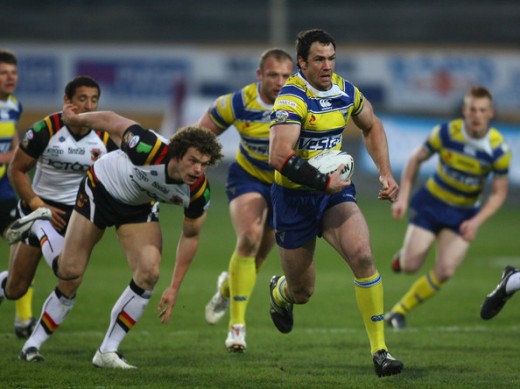Lies, damn lies and Sports stats. – Rugby League.

The amount of statistics kept on sport continues to increase, some far more interesting and revealing than others. In terms of them being true performance indicators I’m left wondering if the correct statistics are being kept and analysed. ‘Moneyball’, is a book by Michael Lewis that follows the Oakland As baseball team for a season, they are a team that has the second lowest wage bill in the league, but consistently win more games than virtually every other team during the season. Billy Beane is the general manager of the Oakland As, because of his limited budget he has to look for value for money in every player he signs. The way he goes about doing that flies in the face of a lot of established Baseball ‘wisdom.’ He picks his players largely from their stats, but he puts the biggest emphasis on the sort of stats that other Baseball insiders don’t consider to be that important. The results of his team on the field strongly suggest that Mr Beane is onto something. It started me thinking about all the stats that are kept on other sports and whether the emphasis is being put on the correct ones, and whether other stats should be kept. I’ve started my in depth look with the sport of Rugby League.
Rugby League stats tend to be a strange mix of Australian, British and American jargon. As with most sports the terminology is often confusing to all but the keenest of followers and shows little regard for the English language. Looking at the Super League website, the elite league of the sport in Europe, their statistic section covers the following areas; tries, try assists, appearances, goals, drop goals, metres, carries, tackles, offloads, attacking kicks, runs from dummy half, tackle busts, marker tackles, clean breaks, forty twenty, kicks in general play, missed goals, missed tackles, errors, penalties, red cards, yellow cards.
Looking at those stats from the point of view of trying to determine the value of a player to a team, obviously some are far more useful than others. Ultimately it’s points on the scoreboard that determine the outcome of games, but if statistics are going to be any great use to coaches they need to be showing how those points are created. So even all the stats related to points scoring aren’t really all that useful in themselves. A winger might well have scored thirty tries in a season, but maybe ten of them his mother could’ve scored and all thirty would’ve been scored by any other winger in the competition had they been given those passes in that position. Also it says nothing of how many tries the winger should’ve scored.
Try assists also don’t give a full picture, a winger could turn several poor passes from his centre into tries, and again the stat tells us nothing of the number of times the player should’ve created a try, only for him to not execute the pass well enough or even pass at all. Goal kicking stats are good to keep so you can monitor if you’ve got the correct bloke kicking for your team, but as a tool to assess the value of a player, it is limited to say the least.
Carries, offloads and runs from dummy half are more about quantity than quality. What we really want to know is how good those carries, offloads and runs from dummy half were. What did they create? Were they the correct option to take?
The kicking stats only tell us how often somebody does something, not how well they do it, or again whether it was the correct option to take. Forty twenties are undoubtedly a fantastic way to gain momentum for your team, but even on these we could do with knowing the percentage success rate of these kicks, rather than the total of successes.
Cleary if a player is spending too much time off the pitch because they have been yellow or red carded, then that is something you would take into consideration when assessing that players worth.
Any team would love to produce many ‘tackle busts’ and ‘clean breaks’, but as a reflection of that player those stats can be misleading. Some tackles are easier to bust than others. Clean breaks can be a result of a magical piece of footwork from the ball carrier, but often the break is created by a fantastic pass or a great running line from an option runner who creates the space.
‘Metres gained’ is an American sounding stat, except they would say yards, and in a game where territory is vitally important, it would be an asset to have a team who are all adept at gaining metres. Once again though this stat far from tells the full story, as some metres are far easier to gain than others. For example let’s say Warrington play out a set as follows; the opposition produces a great kick and chase, leaving Riley virtually nowhere to go on his kick return, so he only gains five metres. Markers are ready and defence well set when Hicks scoots the next play, so he doesn’t get far. Now the defence are really pumped up and sensing the chance to trap Warrington deep in their own half. Morley takes a drive down the middle, taking four of the defence to take him down, but still doesn’t make any more than eight metres. Carvel follows the lead of his skipper and produces the same sort of run with the same result, both of them producing a quick play the ball. On the fifth play Bridge arrives with some speed and footwork, runs at those same four players that have just tackled Morley and Carvel, one of whom has been left on the floor, one with his back turned and the other two still back pedalling by the time Bridge gets the ball in his hands, all resulting in Bridge gaining fifteen metres. Has Bridge really done his job better than Riley, Hicks, Morley and Carvell?
The tackle count is probably the oldest of all the Rugby League stats, along with tries scored and goals kicked. Yet hearing that a player has made 48 tackles in a game, does beg the obvious question; ‘did he have a good game, or was he just in the way a lot?’ Coupling the tackle count with the number of tackles a player missed does give you a clearer picture, but still far from everything you’d want to know. Some tackles are clearly harder to make than others. A full back being left one on one with Sam Tomkins or Kyle Eastmond, in a big open space, can surely be forgiven for missing a tackle far easier than somebody missing a tackle down the middle when someone has run straight at them.
‘Errors’ is probably the vaguest stat of all. Do all errors carry the same value? Is knocking on at the play the ball as excusable as dropping a high bomb that’s swirling around in the wind and there’re three opponents challenging for the ball too? Is a lose carry on tackle two, ten metres from your own line, as excusable as flinging out a speculative pass that goes into touch on the last play of the game when you are two points behind?
I’ll now move onto the stats that I think should be looked at in great detail in order to get a true assessment of a Rugby League player. Starting with one that was on that list, that being penalties. A lot of tries at the top level come about when there is a break in the ‘arm wrestle’, resulting in one team either having more than six tackles in a row, or getting to start their set of six close to their opponents line. Certain things cause these breaks, and I believe they dictate what stats are truly important. A common cause of more than six tackles in a row is a defensive penalty. So it would be useful to know how often your player is penalised. As with most stats this would need to be broken down into more detail to give a true picture of the player. For example you would like to know what all the penalties are for, if they are mostly for high tackles then you either have a technique or temperament issue to work on. Also you’d like to know when in the tackle count these penalties are occurring and how excusable the offence is in the coaches’ eyes. For example being caught off side on the second tackle for being a fraction quick out of the blocks, might easily be forgiven merely as a sign of over eagerness. Whereas a pointless flop on tackle five is likely to get even the most mild mannered coach fuming.
A team getting to start their set of six close to the opponent’s line is often the case of a handling error. Most of these errors come when in collision or when trying to play the ball quick. Alarmingly I believe this was the biggest difference between Australia and England in the last four nations, England making too many of the sort of errors you wouldn’t be happy about your under12s team making. Such is the potential effect on the momentum of a game on a handling error, keeping a detailed stat on this will tell you a lot about a players worth. I think a number of handling errors in contact per number of times taking the ball into contact would be the simplest and most effective stat to keep. Any time a pass is dropped you have to look at both the passer and the attempted catcher, so that would be complicated and often a matter of opinion. Any ball carrier knows that whenever he takes that ball into contact, it his responsibility to keep hold of that ball.
Trapping your opponents in goal, forcing them to drop out under their own posts, almost certainly gets you another set of six tackles in their half. Many tries are scored from these sets. So if any kicking stats should be kept, then I would say you’d want to know the number of times a player’s kick leads to a drop out and his percentage success rate with those kicks.
Outside those ‘momentum swing’ factor most people tend to agree that the biggest influencing factor on the outcome of a game of rugby league is the speed each team plays the ball. Therefore I would suggest a great stat to keep would be the average time it takes a player to play the ball. I know there are other factors that influence this, like the speed of the previous play the ball, how many people involved in tackling you and so on, but I still think it would be an extremely useful insight when trying to assess a player. The reverse stat could also be kept, every time a player is involved in a tackle, what is the average speed of the play the ball of the opponent? Our chap who made 48 tackles, might well not have missed any, but if they got a quick play the ball off the back of 40 of those tackles has he really had that good of a game?
When done well, there is no doubt that offloads can cause havoc for a defence. So maybe there should be a stat kept on what percentage of the time when a player is involved in a tackle that the opponent manages to make an off load.
So I wonder if you could put together a team of players who were all high up on the speed of the play the ball stats, were best at limiting offloads, made the fewest handling errors per collision, gave away the fewest penalties and had a couple of kickers adept at forcing drop outs, then would the scoreboard take care of itself?
It might well be the case that many, if not all super league clubs are already keeping these stats, just not making them public. I am a massive believer in sport being about far more than stats, some things no stats can measure for example, character, team spirit, belief, ability to perform under pressure and desire. But if you have the technology and the manpower available to keep stats, you may as well keep the ones that are truly relevant to the game.
I would love to hear any thoughts on my ideas for stats or new ideas for other stats.
To read blurb and sample chapters of my published Rugby League book read my hub http://lupine-rob.hubpages.com/hub/Spirit-of-55



